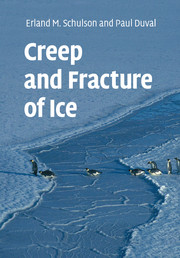Book contents
- Frontmatter
- Contents
- Preface
- Acknowledgements
- 1 Introduction
- 2 Structure of ice
- 3 Microstructure of natural ice features
- 4 Physical properties: elasticity, friction and diffusivity
- 5 Plastic deformation of the ice single crystal
- 6 Ductile behavior of polycrystalline ice: experimental data and physical processes
- 7 Modeling the ductile behavior of isotropic and anisotropic polycrystalline ice
- 8 Rheology of high-pressure and planetary ices
- 9 Fracture toughness of ice
- 10 Brittle failure of ice under tension
- 11 Brittle compressive failure of unconfined ice
- 12 Brittle compressive failure of confined ice
- 13 Ductile-to-brittle transition under compression
- 14 Indentation fracture and ice forces on structures
- 15 Fracture of the ice cover on the Arctic Ocean
- Index
- References
3 - Microstructure of natural ice features
Published online by Cambridge University Press: 01 February 2010
- Frontmatter
- Contents
- Preface
- Acknowledgements
- 1 Introduction
- 2 Structure of ice
- 3 Microstructure of natural ice features
- 4 Physical properties: elasticity, friction and diffusivity
- 5 Plastic deformation of the ice single crystal
- 6 Ductile behavior of polycrystalline ice: experimental data and physical processes
- 7 Modeling the ductile behavior of isotropic and anisotropic polycrystalline ice
- 8 Rheology of high-pressure and planetary ices
- 9 Fracture toughness of ice
- 10 Brittle failure of ice under tension
- 11 Brittle compressive failure of unconfined ice
- 12 Brittle compressive failure of confined ice
- 13 Ductile-to-brittle transition under compression
- 14 Indentation fracture and ice forces on structures
- 15 Fracture of the ice cover on the Arctic Ocean
- Index
- References
Summary
Introduction
The microstructure of a natural ice feature is a direct result of its thermal-mechanical history. Glaciers, for instance, form from snow through the processes of sintering and densification. At the surface, sintering of dry snow is driven by a reduction in surface and grain boundary energy. Below a depth of 2–3 m, density increases under the combined effects of particle rearrangement and sintering. Snow gradually changes into firn, a form of porous ice of relative density of about 0.6. The transition marks the end of particle packing as the dominant densification process. Firn densifies mainly through creep. Closed pores progressively form, leading to bubbly ice. In polar ice sheets, depending upon the snow accumulation rate and temperature, the transition from firn to bubbly ice occurs at a relative density between 0.82 and 0.84 (Arnaud, 1997). At the close-off density, ice contains cylindrical and spherical pores. The density of bubbly ice increases with depth, and the pressure within bubbles progressively increases. In polar sheets, bubbles transform into hydrate crystals below a depth of 500 m (Miller, 1973). The evolution of the microstructure with depth depends on temperature, strain rate and impurities, and depends as well on grain growth and recrystallization. The grain size of the ice that eventually forms is typically between a millimeter and several centimeters (Chapter 6).
- Type
- Chapter
- Information
- Creep and Fracture of Ice , pp. 30 - 50Publisher: Cambridge University PressPrint publication year: 2009

